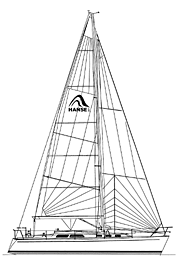Hanse 371
Performance cruiserr
Here's a boat designed by Judel and Vrolijk and built in Greifswald, Germany, by Yachtzentrum Greifswald. Rolf Vrolijk is the designer responsible for the America's Cup boat Alinghi. I have been very impressed with the design work coming from this talented team. This new Hanse is another dual-purpose boat. There is enough comfort to qualify the boat as a cruiser and enough performance to allow you to feel competitive in a PHRF fleet. PHRF is alive and well in Puget Sound, with 60 boats out for last weekend's Grand Prix regatta. It's easy to grumble about PHRF, but in many areas it's the only game in town.
The hull shows short ends for a long sailing length. The D/L is 173. You can have your pick of keels for a 6 foot, 6 inch draft; 5 foot, 6 inch short fin draft; or a 3 foot, 4 inch integral lifting keel. That's quite a selection. I have no drawings for the lifting keel or the short fin but the deep fin has long tip chord and a bulbish shape. Note the marked leading edge/hull fillet. The rudder shows very little taper in plan form, giving it a long tip chord. The forefoot knuckle is well below the DWL and this reduces the amount of fore and aft rocker to this hull. This is a very moderate looking hull. While the beam is carried aft it is not as exaggerated as on some models we have seen recently.
The layout of the Hanse echoes the layouts of the French competition. The broad stern allows for a large double quarterberth. There is a big lazarette to starboard that appears to be accessed from just aft of the galley. In fact, there is an option of a shower here or you can add a mirror image double berth stateroom in this space. Pity though-this door severely limits what you can do with the galley and to my eye this galley looks skimpy. Don't be expecting a balsamic vinaigrette drizzle for your pork loin if I have to cook in this galley.
The saloon looks fine if you like those chairs. I guess I'm just old school. I have never acclimatized to chairs in sailboats. Settees work better because you can sleep on them. Still, chairs are very popular these days. There is no nav station that I can see on these cryptic drawings. I don't see that as a problem. You can spread a chart out on the dining table if you need to and navigation electronics are so compact today they can fit just about anywhere in the saloon. I like nav stations, however. When you have company on board you can sit in the navigator's chair and really feel like the captain. The V-berth area looks spacious and has port and starboard hanging lockers.
This rig is designed around a self-tacking jib that sheets to a traveler mounted on a bracket. I can't tell from the drawings how far outboard this bracket allows the sheeting to go. In a perfect world it would go all the way out to the sheer. The double spreaders are swept.
Note again that this rig is not a masthead rig. There can be no question today that a well-designed fractional rig is faster than a masthead rig. Masthead rigs can be easier to sail though and I think they still deserve consideration for out-and-out cruising boats.
Styling on this boat is a bit too sedate for my taste. The boat has a clean line with moderate proportions, but there is little electricity in its look. The flattish sheerline, the short ends and the boxy cabin trunk work together well and this certainly is not a bad looking boat, I'd just like to see some more exciting styling. Having said that I am aware that many of you prefer sedate styling-blue blazers with a nice club tie. It's a good look. There is no doubt in my mind that this model will win many friends.

Comments